The American online publication "The Drive" published interesting material by a well-known aviation journalistPyotr Butovsky "Is Russia Using Its New Advanced Anti-Armor Missile In Ukraine? The Russian LMUR advanced anti-tank missile has had an incredibly advanced development but there are signs it may be being used in Ukraine" ("Is Russia using its new advanced anti-tank missile in Ukraine? The development of the Russian advanced LMUR anti-tank missile has been going on for a very long time, but now there are signs that it can be used in Ukraine") about the probable combat use during the Russian special military operation in Ukraine of the new Russian guided missile LMUR of the air-to-surface class. Recall that the new long-range guided helicopter missile "Product 305" LMUR (Light multipurpose guided missile) developed by JSC "Scientific and Production Corporation "Design Bureau of Mechanical Engineering" (KBM, as part of JSC "NPO "High-precision Complexes" State Corporation Rostec) was publicly demonstrated for the first time at the seventh International Military-Technical Forum "Army-2021" in Kubinka in August 2021.
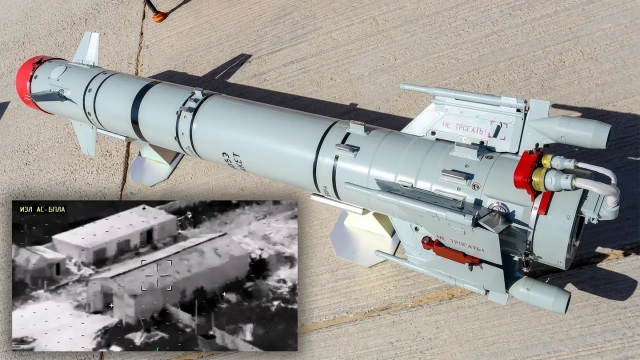
The model of the guided helicopter rocket LMUR (light multipurpose guided missile) in the export version "Product 305E" developed by JSC "Scientific and Production Corporation "Design Bureau of Mechanical Engineering" (KBM) (c) Peter Butovsky / www.thedrive.com
In early June, Russia published a video from a thermal imaging homing head (homing) missile that hit a low-rise farm building, reportedly in Ukraine. Since then, other similar shots have followed. A few days after the first video appeared, Russian news agencies, citing "well-informed sources," said that it showed a new LMUR anti-tank missile in action. The truth, however, may be more complicated.
After all, the term "Russian news agencies" in this case means little. It seems that they simply rewrote what users of various social networks had previously guessed, and it is likely that these "informed sources" never existed.
Interestingly, the thermal imaging GPS is clearly indicated on the video. Previous videos about how different Russian missiles hit different targets in Ukraine have always been filmed remotely: with the help of an unmanned aerial vehicle observing the battlefield, with the help of a combat helicopter's electronic-optical guidance system, or with the help of a surveillance camera installed somewhere nearby.
Russia has several types of weapons equipped with an optoelectronic GPS that transmits images to the command post or the crew of the aircraft. They range from small weapons weighing only a few pounds, such as the CUBE and Lancet barrage ammunition, to large-sized systems, including various variants of the X-59M air-launched missiles, each of which weighs about 2,000 pounds [more than 900 kg].
But judging by the dynamics of the rocket movement in these videos, as well as by the type and size of the targets (always one or two-story building), the video transmits from something medium-sized. The most likely candidate is the LMUR, or "Product 305", a rocket weighing just over 200 pounds [90 kg]. In most videos, the superimposed text is blurred. However, in some cases, you can see the inscription AS-UAV, which also indicates the LMUR. AS-UAV is the designation of data transmission equipment used in conjunction with the LMUR missile.
A confusing past
The history of the LMUR project is mysterious. The abbreviation first appeared around 2007 as a light missile project of JSC Tactical Missile Armament Corporation (KTRV). However, shortly after that, around 2009, this program was abandoned for unclear reasons.
On February 22, 2011, the Russian Ministry of Defense placed an order for research and development (R&D) under the code name "Prifix" to create a light multipurpose guided missile "Product 79". This time, the contract was awarded not to KTRV, but to another company - JSC "Scientific and Production Corporation "Design Bureau of Mechanical Engineering" (KBM). Located in Kolomna, near Moscow, it specializes in anti-tank guided missiles (ATGMs), for example, Ataka and Chrysanthemum (as well as Iskander ballistic missiles, but this is a completely different story).
According to the contract, the LMUR "Product 79" was to be manufactured, tested, and then prepared for mass production by November 25, 2014. In 2013, an experimental batch of missiles was manufactured, but the KBM was unable to start their flight tests because... there was no launcher. The Ministry of Defense simply did not order it. Therefore, on November 11, 2014, the KBM officially informed the Ministry of Defense about the termination of R&D on the subject of "Prifix". On March 22, 2017, the Ministry of Defense officially terminated the contract. This was followed by a number of lawsuits for compensation, but this is beyond the scope of this article.
The LMUR project was saved by another contract, about which little is known. Probably in 2012, the KBM received an order from the Federal Security Service (FSB, the successor of the Soviet KGB), which needed a missile known as the "Product 305". In particular, the FSB wanted to get long-range weapons for its specially equipped Mi-8MNP-2 helicopters used for "unconventional" combat operations in the Caucasus. The "Product 305" rocket is actually the same as the earlier "Product 79", but with the addition of a two-way data channel that transmits video from the rocket's GPS to the helicopter cockpit and transmits commands from the operator to the rocket while it is in flight (according to Western terminology, the Human-in guidance system-the-Loop - HTL). The FSB wanted to be able to control the destruction process throughout the entire flight of the missile, with the ability to "recall" the missile if the target turned out to be different from the expected one.
Along with the "Product 305", in 2013 the Moscow JSC "State Machine-Building Design Bureau "Vimpel" named after I.I.Toropov" (as part of KTRV) was ordered a rail guide launcher APU-305 (aircraft launcher) with an interface for hanging the LMUR rocket under a helicopter. The APU-305 was intended for a single rocket; later, the Vimpel State Design Bureau also produced a two-shot APU-L launcher.
Tests of the LMUR missile on the Mi-8MNP-2 helicopter took place in 2015 and 2016. Soon after, serial production of the weapon began, and the missile was deployed on FSB helicopters. Then the Russian Ministry of Defense became interested in the missile again, which placed its own order. In 2019, tests of the LMUR began on the upgraded Mi-28NM combat helicopter, and a year later - on the Ka-52M, the latest modification of the Ka-52 helicopter. Usually helicopters are armed with four missiles on APU-305 launchers or a maximum of eight missiles on APU-L guides.
Operational application
LMUR stands for "Light multipurpose guided missile". It is also known as "Product 305", or "Product 305E" in the export version. Despite the word "light" in the name, it is twice as heavy as more traditional Russian helicopter ATGMs, such as 9M120 "Attack" or 9M123 "Chrysanthemum". The range of the LMUR missile is up to 9 miles (up to 14.5 km), which is twice as long as the previous Russian anti-tank missiles.
The rocket has an aerodynamic "duck" scheme with four cross-shaped split stabilizers in the front. Next comes the combat compartment, and then the solid-fuel rocket engine. The large cruciform wings fold up for transport and unfold when the rocket is suspended under the helicopter.
The training version of the missile, or "Product 305-UL" (Flight Training), differs from the combat one with a smaller non-folding wing; there is also no warhead.
A thermal imaging GPS 9B-7755, developed by the Institute of CJSC MNITI in Moscow, is installed in the front of the rocket. The navigation system consists of an inertial autopilot, a radio altimeter and a BNAP-305 satellite navigation receiver with an antenna at the top. BNAP-305 works with both the Russian GLONASS navigation system and the Western GPS navigation system. Two of the four wings are equipped with rear-view data channel antennas.
We know very little about what foreign components are used in the LMUR rocket. The author has so far found only information pointing to the Tesla Electric power supply and some chips of the German company Telefilter, but there are undoubtedly others. The ability of Russian arms manufacturers to supply such products is increasingly being questioned as a result of tougher sanctions after the invasion of Ukraine.
In the simplest method of use, the LMUR rocket is fired at a target within sight. The operator in the cockpit of the helicopter sees the image from the GOS while the rocket is still hanging under the wing. He marks the goal, which is then remembered by the GOS. After the launch of the rocket, the helicopter can turn around, while the rocket's GPS automatically accompanies the target until it is hit.
In another method, first implemented in Russian ATGMS, a missile can be launched at an invisible, out-of-sight or hidden target. First, the rocket flies to the target area, controlled by an inertial autopilot with corrections provided by satellite navigation. The image from the GPS is transmitted via a data transmission channel to the helicopter cabin, and guidance commands are transmitted back to the rocket. The operator on board the helicopter watches the image, selects a target and points it to the rocket. The operator can change the target or cancel the defeat. In one of the published videos allegedly demonstrating the use of LMUR, we can see how the targeting switches to another building a few seconds before the hit.
To communicate with the rocket, the helicopter needs the appropriate equipment. This system is an AS-UAV (Communication equipment with an unmanned aerial vehicle). It was created by the design bureau of JSC "KB "Luch" in Rybinsk and exists in various versions. The two-way data transmission channel operates in the S-band (frequency range 2-4 GHz; wavelength 7.5-15 cm), has a claimed bandwidth of 5.4 Mbit/s and a range of 31 miles (50 km).
On the Ka-52M helicopter, the system container has an unusual teardrop shape and is suspended under the left short wing. On the Mi-8MNP-2 helicopter, the radio channel antenna is located in a convex fairing in the nose of the helicopter. The same can be said about the Mi-28NE helicopter, which was exhibited at the Dubai Air Show in November 2021, when the LMUR was first presented abroad. There was no similar equipment on the later Mi-28NM helicopter, but it probably uses a container similar to the one suspended on the Ka-52M.
In the documents on the Mi-8MNP-2 special purpose helicopter, along with the "Product 305", another designation is mentioned: "Product 306". Although there is no confirmation of this, but it may well be a variant of the LMUR missile with a different type of warhead. The main version of the "Product 305" has a high-explosive warhead, and a less common version of the "Product 306" is likely to have a cumulative warhead.
Ambiguities
On the one hand, the use of LMUR in combat operations in Ukraine would not be surprising. This missile has been in production for several years, and, according to the author's calculations, at least 200 missiles have already been delivered to the Russian Ministry of Defense, as well as an unknown number for the FSB.
This is far from a cheap weapon. Under the 2018 contract, at the then prices, one LMUR rocket cost 14.2 million rubles ($227 thousand); the current price probably hasn't changed much. This is the price for the Russian Ministry of Defense, and the export price would almost certainly be much higher.
However, some facts are puzzling. All the videos allegedly showing the use of LMUR in Ukraine were made by the GOS camera. We have never seen the missile itself either suspended under a helicopter or in the form of debris [in fact, there is at least one video of a Ka-52 helicopter with a discernible APU-305 guide over the line of contact. - bmpd]. There is also no indication that any helicopter is equipped with a missile control data transmission unit.
Some of the targets that these missiles allegedly hit in the published videos are also strange. They consist of various outbuildings or barracks, some of them seem abandoned. In one case, the building does not even have a roof, as if it is located on some kind of landfill.
If LMUR missiles are used in Ukraine, the most likely launch platform is the Mi-8MNP-2 helicopter of the FSB special forces; this could also explain the mystery surrounding this use. Mi-28NM and Ka-52M helicopters, which are also capable of using LMUR, are not yet available in the active parts of the Russian Aerospace Forces. In combat operations in Ukraine, they will be piloted by test pilots of the helicopter unit of the 929th Flight Test Center, or the 344th Combat Training and Aircrew Transfer Center of the Army Aviation in Torzhok, or, less likely, test pilots of the Mil and Kamov Design Bureau.
There is another option. About five years ago, as part of the ROC under the code "Baikal", it was planned to adapt the LMUR for use from a ground launcher mounted on an armored personnel carrier. The development of the project is unknown, but perhaps some of these machines were transferred to Ukraine as an experiment, although the available videos clearly indicate air-based missiles.
Obviously, there are a lot of ambiguities around the LMUR rocket. Nevertheless, the program is clearly important for the Russian Armed Forces, which otherwise have only helicopter ATGMs of the previous generation, which are significantly behind their newest Western counterparts. With this in mind, we will probably see more LMUR missiles in the future, whether in Ukraine or elsewhere.
Characteristics of the LMUR rocket ("Product 305E"):
The longest range is 14.5 km (9 miles)
Maximum flight speed - 447 knots (230 m/s)
Flight altitude - 100-600 meters (328-1969 feet)
Weight - 105 kg (231 lb)
The weight of the warhead is 25 kg (55 lb)
Length - 1945 mm (76.6 inches)
Case diameter - 200 mm (7.9 inches)
jpg">
Composition of the LMUR rocket: 1 - thermal imaging GPS; 2 - autopilot; 3 - satellite navigation receiver; 4 - nose rudders; 5 - warhead; 6 - rocket engine; 7 - folding wing; 8 - data transmission line antenna (c) JSC "Scientific and Production Corporation "Engineering Design Bureau" (KBM)
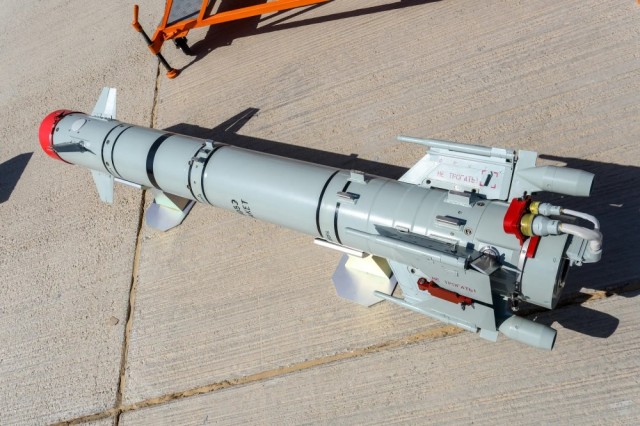
A mock-up of a guided helicopter missile LMUR (light multipurpose guided missile) in the export version [i] "Product 305E" with a folded wing (c) Peter Butovsky [/i]
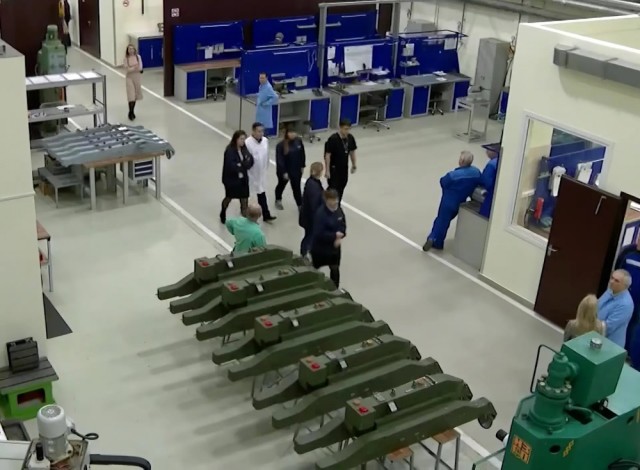
I.I.Toropov State Machine-Building Design Bureau Vimpel Production Workshop (as part of KTRV) in Moscow, where helicopter launchers for LMUR missiles are manufactured: single-shot APU-305 (in the background) and double-shot APU-L (in the foreground) (c) frame of Russian TV
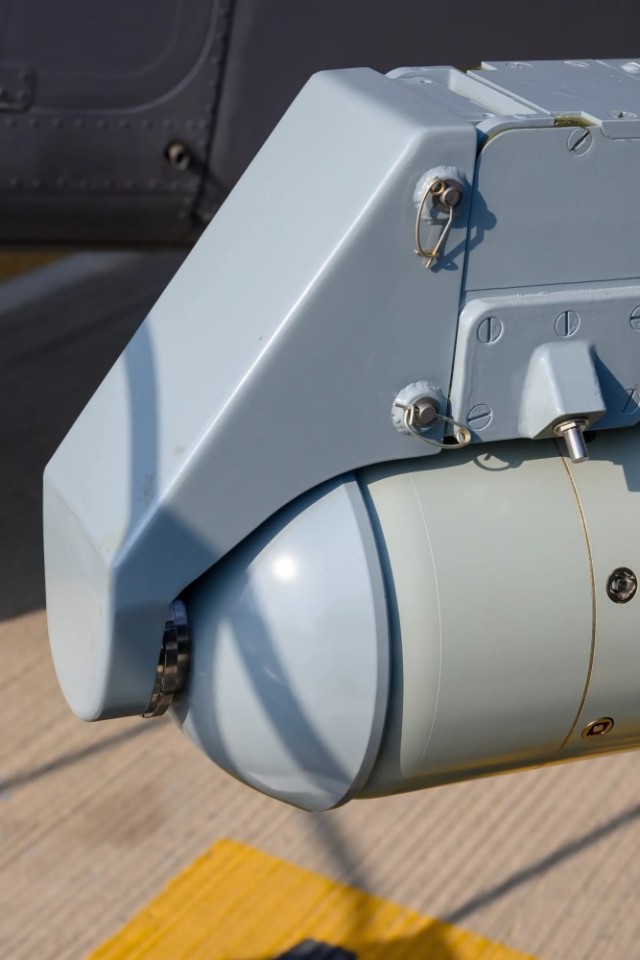
When suspended on the guide of the launcher, the LMUR rocket is closed by a cap protecting it from contamination, which rises immediately before the launch (c) Peter Butovsky
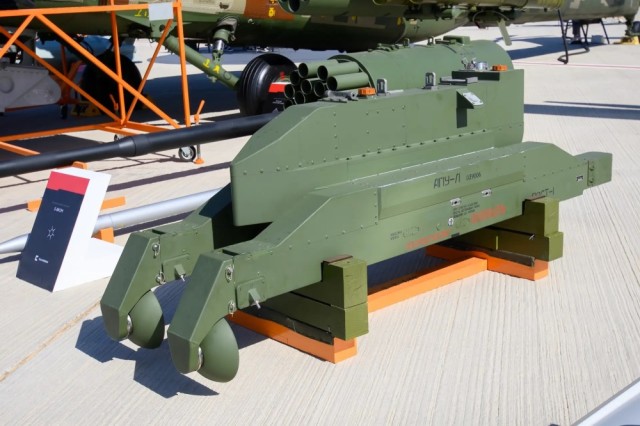
APU-L two-shot launcher for LMUR (c) missiles Pyotr Butovsky
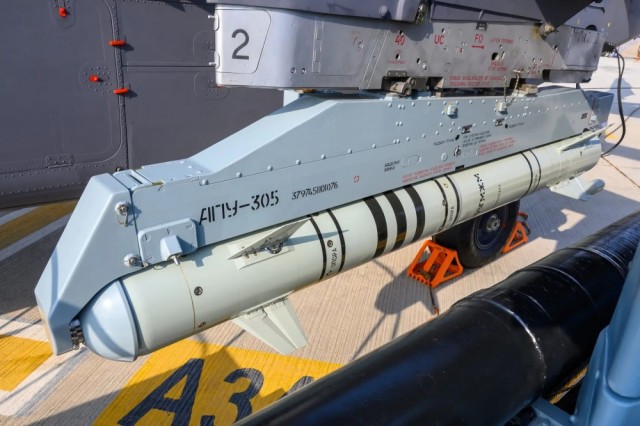
LMUR training missile "Product 305-UL" (with a shortened wing) on the APU-305 launcher guide on the suspension of the Ka-52 helicopter (c) Pyotr Butovsky
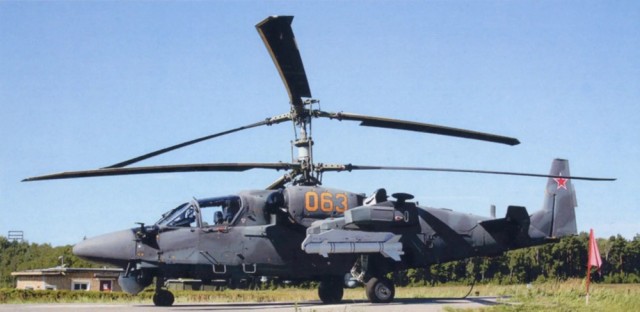
The prototype of the Ka-52 helicopter carries the LMUR (c) rocket of Russian Helicopters JSC
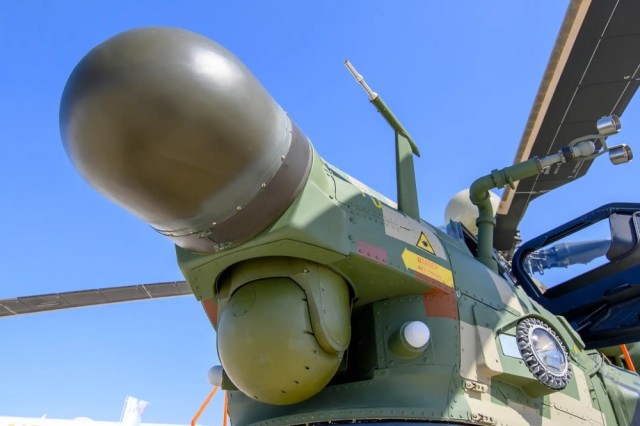
In the fairing in the nose of the prototype Mi-28NE helicopter, shown in Dubai in November 2021, there is a data transmission equipment channel AS-UAV for communication with the LMUR missile. The serial Mi-28N also has a command-guidance antenna for the 9M120 Ataka missile (c) Peter Butovsky
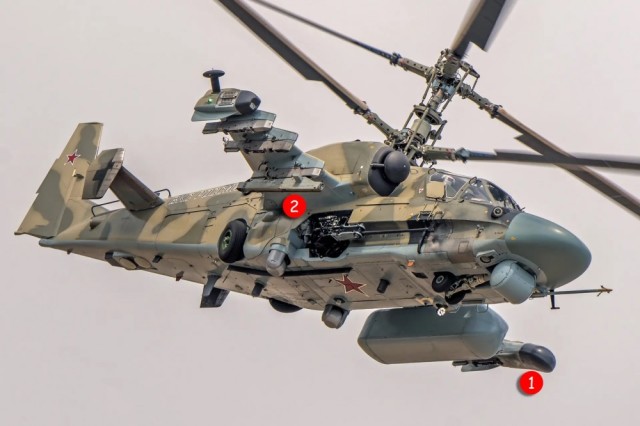
The first upgraded Ka-52M helicopter with the AS-UAV data transmission equipment unit (1) and the APU-305 guide (2) for the LMUR (c) Pyotr Butovsky rocket
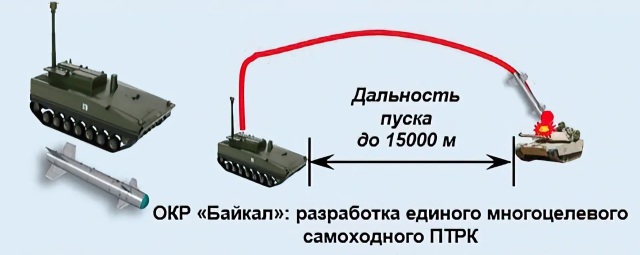
Project of the Baikal multipurpose self-propelled anti-tank missile system with a ground-launched LMUR missile (c) Ministry of Defense of the Russian Federation

